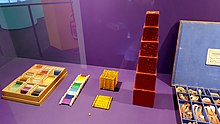
Back Montessori-onderwys Afrikaans منهج مونتيسوري Arabic Métodu Montessori AST Montessori təlimi Azerbaijani Mètode Montessori Catalan خوێندنی مۆنتیسۆری CKB Montessori škola Czech Montessoripädagogik German Μέθοδος Μοντεσσόρι Greek Montesoria pedagogio Esperanto


The Montessori method of education is a type of educational method that involves children's natural interests and activities rather than formal teaching methods. A Montessori classroom places an emphasis on hands-on learning and developing real-world skills.[2][3] It emphasizes independence and it views children as naturally eager for knowledge and capable of initiating learning in a sufficiently supportive and well-prepared learning environment.[4] It also discourages some conventional methods of achievement, such as grades and tests.[4]
The method was started in the early 20th century by Italian physician Maria Montessori, who developed her theories through scientific experimentation with her students.[5] the method has since been used in many parts of the world, in public and private schools alike.[6]
A range of practices exist under the name "Montessori", which is not trademarked. Popular elements include mixed-age classrooms, student freedom (including their choices of activity), long blocks of uninterrupted work time, specially trained teachers, and prepared environment. Scientific studies regarding the Montessori method report generally favorable outcomes for students.[7][8][9][10]
- ^ "What are phonograms and how they are taught to children". The Montessorian wordpress. 22 May 2011. Archived from the original on 26 March 2014. Retrieved 26 March 2014.
- ^ Zuckerman, Oren (2010). "Designing digital objects for learning: lessons from Froebel and Montessori". International Journal of Arts and Technology. 3 (1): 124. doi:10.1504/IJART.2010.030497. ISSN 1754-8853.
Montessori's learning objects are aimed at surfacing a specific abstract concept through hands-on manipulation
- ^ Jones, Stacy (11 August 2020). "Computers and Technology in Montessori Schools". Montessori For Today. Archived from the original on 5 June 2024. Retrieved 29 June 2022.
- ^ a b Lillard, Angeline S. (1 December 2019). "Shunned and Admired: Montessori, Self-Determination, and a Case for Radical School Reform". Educational Psychology Review. 31 (4): 939–965. doi:10.1007/s10648-019-09483-3. ISSN 1573-336X.
- ^ Thayer-Bacon, Barbara (2012). "Maria Montessori, John Dewey, and William H. Kilpatrick". Education and Culture. 28 (1): 3–20. doi:10.5703/educationculture.28.1.3. ISSN 1085-4908.
- ^ Fleming, David J.; Culclasure, Brooke Taylor; Warren, Hannah; Riga, Ginny (17 September 2024). "The Challenges and Opportunities of Implementing Montessori Education in the Public Sector". Journal of Montessori Research. 10. doi:10.17161/jomr.v10i2.22574. ISSN 2378-3923.
- ^ Marshall, Chloë (27 October 2017). "Montessori education: a review of the evidence base". npj Science of Learning. 2 (1): 11. Bibcode:2017npjSL...2...11M. doi:10.1038/s41539-017-0012-7. PMC 6161506. PMID 30631457.
- ^ Eşi, Marius-Costel (20 June 2024). "Sciendo". Journal of Education, Society & Multiculturalism. 5 (1): 72–86. doi:10.2478/jesm-2024-0005.
- ^ Stewart, Roger A.; Rule, Audrey C.; Giordano, Debra A. (4 July 2007). "The Effect of Fine Motor Skill Activities on Kindergarten Student Attention". Early Childhood Education Journal. 35 (2): 103–109. doi:10.1007/s10643-007-0169-4. ISSN 1082-3301.
- ^ Bhatia, Punum; Davis, Alan; Shamas-Brandt, Ellen (19 May 2015). "Educational Gymnastics: The Effectiveness of Montessori Practical Life Activities in Developing Fine Motor Skills in Kindergartners". Early Education and Development. 26 (4): 594–607. doi:10.1080/10409289.2015.995454. ISSN 1040-9289.